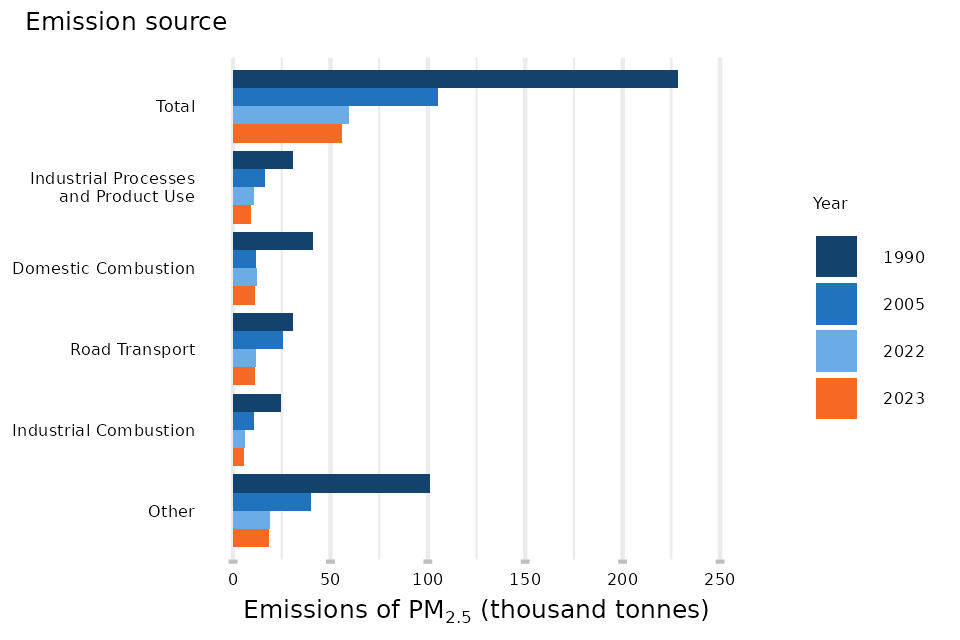What are the Sources and Effects of PM2.5?
What is Particulate Matter? What is PM2.5?
Particulate matter (PM) is a term used to describe the mixture of solid particles and liquid droplets in the air. It can be either human-made or naturally occurring. Some examples include dust, ash and sea-spray. Particulate matter (including soot) is emitted during the combustion of solid and liquid fuels, such as for power generation, domestic heating and in vehicle engines. Particulate matter varies in size (i.e. the diameter or width of the particle). PM2.5 means the mass per cubic metre of air of particles with a size (diameter) generally less than 2.5 micrometres (µm). PM2.5 is also known as fine particulate matter (2.5 micrometres is one 400th of a millimetre).
Health Effects of PM
Inhalation of particulate pollution can have adverse health impacts, and there is understood to be no safe threshold below which no adverse effects would be anticipated. The biggest impact of particulate air pollution on public health is understood to be from long-term exposure to PM2.5, which increases the age-specific mortality risk, particularly from cardiovascular causes. Several plausible mechanisms for this effect on mortality have been proposed, although it is not yet clear which is the most important. Exposure to high concentrations of PM (e.g. during short-term pollution episodes) can also exacerbate lung and heart conditions, significantly affecting quality of life, and increase deaths and hospital admissions. Children, the elderly and those with predisposed respiratory and cardiovascular disease, are known to be more susceptible to the health impacts from air pollution. Potential mechanisms by which air pollution could cause cardiovascular effects are described in the Committee on the Medical Effects of Air Pollution (COMEAP) report “Cardiovascular Disease and Air Pollution”.
Sources of PM2.5
Human-made sources of PM2.5 are more important than natural sources, which make only a small contribution to the total concentration. Within UK towns and cities, emissions of PM2.5 from road vehicles are an important source. Consequently, levels of PM2.5 (and population exposure) close to roadsides are often much higher than those in background locations. In some places, industrial emissions can also be important, as can the use of non-smokeless fuels for heating and other domestic sources of smoke such as bonfires. Under some meteorological conditions, air polluted with PM2.5 from the continent may circulate over the UK – a condition known as the long range transportation of air pollution. Long range transport, together with pollution from local sources, can result in short term episodes of high pollution which might have an impact on the health on those sensitive to high pollution.
In addition to these direct (i.e. primary) emissions of particles, PM2.5 can also be formed from the chemical reactions of gases such as sulphur dioxide (SO2) and nitrogen oxides (NOx: nitric oxide, NO plus nitrogen dioxide, NO2); these are called secondary particles. Measures to reduce the emissions of these precursor gases are therefore often beneficial in reducing overall levels of PM2.5.
Primary emissions of PM, the formation of secondary PM within the UK and long range transport of pollution from outside the UK all contribute to regional PM levels across the UK. Local primary emissions are also important in urban areas.

Figure 1. UK annual emissions of PM2.5 by major emissions sources: 1990, 2005, 2022 and 2023 (Source: Emissions of air pollutants in the UK – Particulate matter (PM10 and PM2.5))
Distribution of Air Pollution
With the exception of ozone, concentrations of air pollutants are generally higher in urban than rural areas. For PM2.5, there is a gradient in concentration across the country with higher concentrations found in the South East than other areas. Within cities, air quality (particularly in relation to concentrations of PM10 and NO2) tends to be worse close to busy roads, where poorer communities often live.
For further information on this subject, please refer to the UK Compliance Study Action Plans and the latest Air Pollution in the UK report, plus the documents linked below.
Documents
World Health Organisation Global Air Quality Guidelines (2021)
Released: 2021 (PDF, 7MB, 300 pages)
Hosted on www.euro.who.int
Cardiovascular Disease and Air Pollution
Released: February 2006 (PDF, 1.75MB, 215 pages)
Hosted on www.gov.uk
Fine Particulate Matter (PM2.5) in the UK
Released: 2012 (PDF, 12.7MB, 203 pages)
Hosted on www.uk-air.defra.gov.uk
